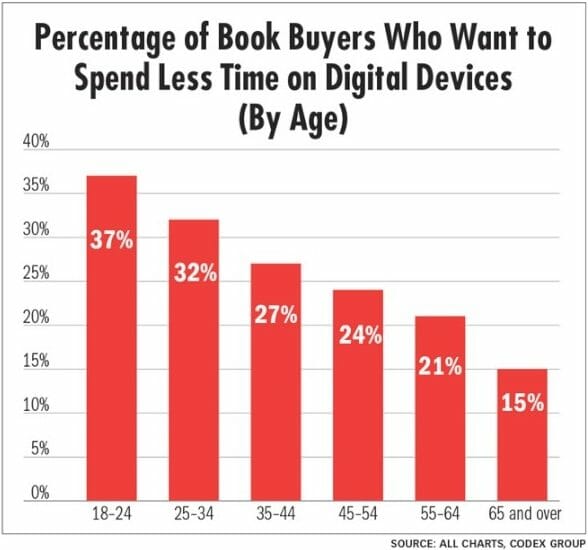Back in 2012, I shared with my own author community that I suspected that “e” …or digital books would begin to decline in sales. In 2013, “e” sales were reporting a decline that has continued. I know, I know—many of you will report that your “e” sales are healthy or increasing. But, overall, the reading “e” world is not growing in leaps in bounds.
According to this article on Publishers Weekly:
“Preliminary figures from the Association of American Publishers found that sales of e-books for trade publishers fell 14% in 2015 compared to 2014 and accounted for 20% of overall trade book revenue, down from 23% in 2014.
Going beyond AAP’s member publisher sales performance, the Codex Group’s April 2016 survey of 4,992 book buyers found that e-book units purchased as a share of total books purchased fell from 35.9% in April 2015 to 32.4% in April 2016. The Codex survey includes e-books published by traditional publishers and self-publishers and sold across all channels and in all categories.”
Print books still earn the title of having the strongest presence with eBooks a distant #2 and audiobook sales showing a double-digit growth again this past year—but still trailing eBooks at #3. Anything with a double digit, multi-year growth should get your attention. Yet, it’s a segment that you don’t want to ignore—especially with the Millennial and YA markets.
The Codex survey revealed that:
“book buyers stated they spent almost five hours of daily personal time on screens (computers, tablets, eReaders and smartphones). Of those, 25% of book buyers, including 37% of those 18–24 years old, want to spend less time on their digital devices.”
Of course book buyers have options as to what format they want their books—print, eBook or audiobook. What they revealed in the survey was that:
“they are reading fewer e-books than when they started reading that format, the highest percentage among all age groups.”
What’s the summing up?
“Overall, 14% of book buyers said they are now reading fewer e-books than when they started reading books in the format, and 59% percent of those who said they are reading fewer e-books cited a preference for print as the main reason for switching back to physical books.”
The primary reason: digital fatigue or eBook sales erosion.
Taking the study in, I had dinner with a group I gather with every few months, this past week. The twelve of us were varied, like most circles of friends. Some “e” lovers; some “p” devotees; some “a” cheerleaders; and some “I love them all.” Sharing the above info … opinions and reflections were tossed out. Interesting, all shared they were reading more print books—I like the feel and look of a book. A few said they loved the “e” format for travel and bedtime reading—I don’t disturb my spouse and I don’t have to carry an extra suitcase for books on the road. And a few said—I listen to audio when I’m working in my shop; it’s perfect for road trips.
Interesting.
Physical audio sales (meaning CDs) are down slightly—so where is the double digit (as in 20% plus for the last two years) coming from? It’s all in the download factor. All those earbuds you see walking around, quietly sitting in the owners ears and just “playing” in the background are listening to “something”… and that something is increasingly a book. The category hit record growth in both units (+27.0%) and revenue (+26.8%) over 2013. Audiobooks are soaring with the “downloaded” feature … even through the new model cars. Did you know this?
Two weeks ago, I finished the narration of my new book, How to Avoid 101 Book Publishing Blunders, Bloopers & Boo-Boos. In the recording studio, I asked my editor, Richard Rieman what trends he was experiencing. Richard wears multiple hats—audio editor, book narrator, voice over professional and now author of The Author’s Guide to AudioBook Creation.
“Think of it as the Audiobook Revolution. With audiobook sales up over 20% two years in a row and Audible listening up 38%, there is revolutionary growth in audiobooks.”
What does that mean for authors today? Simply this: sticking to one format for publishing your books are making a mistake. Authors who choose to exclusively publish with the “e” only format are missing sales—as they are with just the “p” choice. In fact, Rieman shared that,
“In some cases, such as The Martian, audiobook versions are registering three or four times the sales number of the original work. They are, in effect, replacing the text version as the primary version of the book.”
Really interesting … wouldn’t you say?
I’ve always said that authors are making huge mistakes when they think of themselves as one-book ponies. Books breed books—and by creating more and more, you develop followers—the Super Fans that will cheer and support who you are when they discover how terrific your books are. By offering books in only print or eBook or audiobook, you are a one-format pony. Don’t be. We authors need to deliver our books in multiple options, just as a restaurant does. Hamburger joints have “sides” and “variations” to attract those who don’t eat burgers.
Presently, I have all my books in print; all current ones in “e” and a few in audio—my personal goal is to get all current ones into the audiobook format and then do an assessment of which “oldies” might enjoy a resurrected life.
Why? …
I avoid digital fatigue that only an eBook will produce; I’ve opened up to the huge market that is the listener market (and maybe the multi-tasker as well); and I deliver a variety of options. What about you … what options are your books in? Are they delivering what you expected? How about what your readers would like?
Photo: pixabay.com. Amazon links contain my affiliate code.



